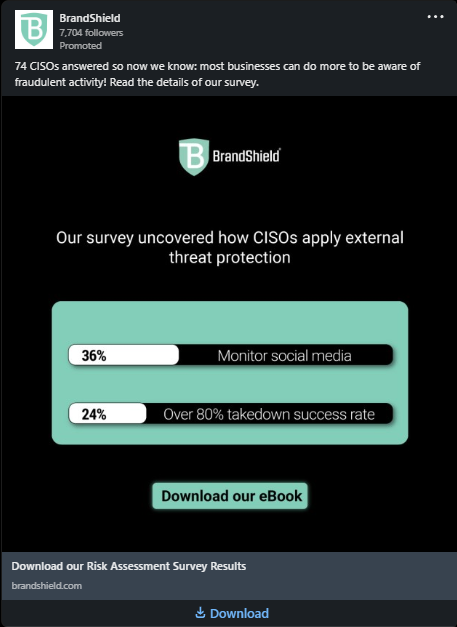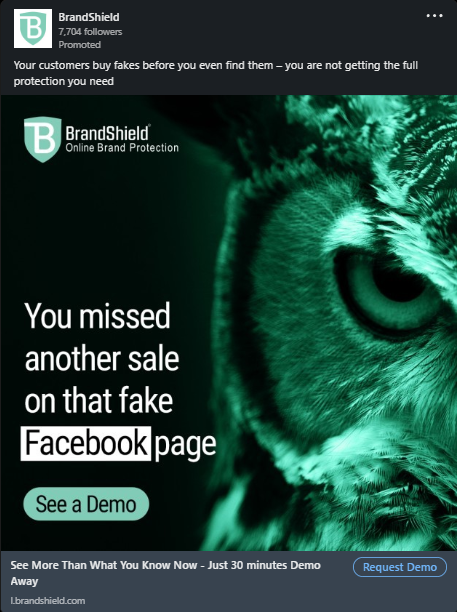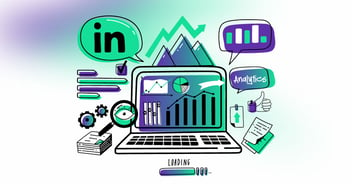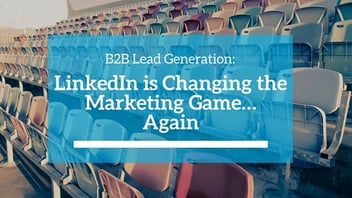
LinkedIn LeadGen Tips for Cyber Security Marketers
LinkedIn is comfortably the world's largest professional social media network, roughly 950 million members from more than 200 countries around the world. That’s a lot of people, and therefore it’s a lot of opportunities to get your message across. However, it’s key that you are targeted in your approach, and not just casting as wide a net as possible in your attempts to generate leads.
Luckily, LinkedIn provides a host of native campaign and lead generation tools that can help your company, and your message stand out in the crowded cyber security market. But before you dive head first into LinkedIn advertising, here are some top tips to make sure you're moving in the right direction.
Content is king
No amount of marketing will sell a bad product - This is a phrase we repeatedly hear. But it couldn't ring more true in the cyber security field. Before you begin advertising on Linkedin, you MUST ensure that the content you create actually resonates with your target audience and will interest them. Too many times, we see company ads on LinkedIn promoting poor content. While it may initially generate clicks, it will do little to generate leads or sales, and may even have an adverse effect on sales. It’s also important to consider that if you produce poor content and don't share anything new or important to the prospect (or worse is inaccurate), what does that say about your product? The answer - Nothing good.
Only by providing valuable content that resonates with your audience can you initiate the customer journey on the right path. This process often starts with the creation of a customer persona(s). This will help you identify what your audience's pain points are, in order to understand how to position your product and what you should communicate to them. You may discover that you have several personas - They could be the CISO, DevOps Manager or DevOps Engineer to name a few. Each of these will require different content and have different goals. Only by tailoring your message and content as such can you hope to have any success on LinkedIn.
Ah yes, the marketing funnel
You will also need to ensure that you create content at all stages of the buyers funnel - a cold lead who has no awareness of you or your company is unlikely to wish to book a demo of your product or service (no matter how awesome it may be!). Instead they need to be nurtured, and guided through the funnel by being shown relevant content based on their lifecycle stages.
For example - At top of funnel stages you may want to show blogs or ‘how to’ videos; at middle of funnel stages you may want to show comparisons, eBooks or on-demand webinars etc, and at lower funnel stages you may want to give a book a demo or free trial options.
See how to build your B2B messaging for success!
Types of LinkedIn ads
Before we look at some specific best practices you should implement across your LinkedIn campaigns, let’s take a look at the most common advertisement formats you can employ.
- Lead gen ads: These allow you to generate leads directly on LinkedIn through the use of downloadable content, which requires user information in order to be accessed (more on these later!).
- Text ads: These are the most visually simple ads and the most budget friendly. You can use content variations in the same campaign to find the most effective option.
- Sponsored content: These show up on the homepage, blending in with user posts. Because these aren't grouped in the known advertising space. As a result they often have higher CTR rates than ads.
- Sponsored InMail: These are personalized messages to a prospect's LinkedIn inbox. They work well in campaigns such as inviting prospects to a webinar or offering a free trial. InMail works on a "cost per send" model.
- Event ads: These allow you to promote an upcoming event you are hosting either virtually (Webinar) or in-person in order to generate registrations.
- Document Ads: Document ads allow advertisers to collect leads, through lead gen forms while also engaging audience interest in your content offering through newsfeed downloads.
- Video Ads: Video ads are a great way for advertisers to increase brand awareness as video ads are very engaging in comparison to static image ads. This is because video ads don’t just tell a story, they show one.
Best Practices for Ads on LinkedIn
We’ve run our fair share of LinkedIn campaigns over the years - Some worked, some didn’t. But we’ve continually refined our approach and have distilled some best practices that you can apply today to achieve maximum results.
- Be very clear what the offer is and who it’s for: Generally speaking you're going to use a CPC model on LinkedIn so you want to make sure that the message speaks to the audience and entices them to click… Otherwise it’s a waste of money - And who wants that?
- Align the copy and headlines in your ads and landing pages: This is an important concept in integrated marketing and will greatly enhance your overall performance
- A/B Test: One of the most important points on the list - Make sure you A/B test your ads in order to maximize their performance over time.
- Consider calling out your buyer directly: For example, adding ‘Hey CEO’s ….’ in post copy can help increase immediate relevance
- Highlighting an interesting stat or fact, either in the image or in post copy can help grab attention in feed and make your offering stand out
- Use pain points and how your solution can solve them: For example; On average, CISOs waste 8 hours per week doing ___.
- Provide LinkedIn with the optimal number of ads per campaign (4-6 ads): You don’t need to have different banners and creative for each ad. For example, you can play with 1 copy and different banners or 1 banner and different ad copies.
- Don’t use #’s in ad copy: Hashtags have their place in organic social, however they shouldn’t be used in paid campaigns. They can take people away from your ad when they click on it. And why would you want that?!
Real-world examples
Here are 2 examples of advertisements we like from cybersecurity company, BrandShield.
These advertisements really caught our eye as great of examples well-crafted LinkedIn advertisements - But why? There are many reasons for this, here are our top 3:
- They are simple, to the point, and explain exactly what the reader will receive in a clear, concise manner - In this case either a 30 minute demo or a downloadable risk assessment survey
- The in-image text contains thought provoking text, statistics, as well as a clear call-to-action
- The text used in the first speaks directly to the target audience - CISOs, and the stats do a great job in garnering attention
- The imagery used in the second example is eye-catching, and succeeds in grabbing the users attention right off the bat
LinkedIn LeadGen Forms vs. Landing Pages
When building out your LinkedIn campaign, one of the first things to consider is your conversion objective - In other words, lead generation forms or website conversions. Let’s explore the key differences.
LinkedIn leadgen forms allow people to input their information directly on LinkedIn in exchange for whatever content piece (eBook, Webinar etc) you are promoting. The form fields can be customized to whatever information you require such as name, business email address, company, industry, job title etc (but keep in mind that the more fields you add, the more work is required on the users behalf). However, as the process is usually automated (and therefore frictionless), in the sense that LinkedIn autofills the information, you’ll *usually* be able to generate a higher number of leads.
On the other hand, landing pages are used to direct people to your website, where they can see additional information on the offer and sign up there. Of course, this adds an extra step and external navigation to the process, however you will be able to provide additional information compared to LinkedIn, and people who navigate are potentially more interested in your product/service.
We could debate which of these is better until the cows come home, but from our experience, leadgen forms usually generate a higher number of initial leads, but landing pages have a higher overall conversion rate of prospects into paying clients.
You should of course A/B test both options to see which works best for you!
Read: Cyber Security Benchmarks: Are You Paying Too Much For Your MQLs?
Supercharge your LinkedIn performance with ABM
As we mentioned in the introduction, there are more than 800 million users on LinkedIn - Clearly not all of these are relevant or in your audience. Despite this - You will undoubtedly have a large number of relevant industry personnel to target. A great benefit LinkedIn holds over other channels is the ability to be hyper focused in targeting specific user accounts or companies - AKA, Account Based Marketing (ABM).
ABM is a marketers dream as it ensures greater alignment between sales and marketing… No more conversations like:
- But we brought you 500 leads…
- They weren’t good, we couldn’t generate any interest!
- But we brought them nonetheless…
Sound familiar?
We’ve been running ABM campaigns for several years, but only in the last 1-2 years has the potential, and popularity of it really taken off. A major benefit of ABM on LinkedIn in particular is that it reduces the time and budget you’ll spend on irrelevant accounts, and maximizes the amount you’ll spend on high value accounts. This is because the content is hyper-personalized, meaning the leads experience is better which results in greater overall efficiency and performance. The success ABM can provide is evident in the data also - With 30% of marketers reporting a greater than 100% engagement increase with their C-Level target accounts compared to regular campaigns.
Key takeaways
LinkedIn advertising, when done right, has the potential to be a goldmine for businesses, particularly in the B2B space. However, where many brands fall short is going for bottom of the funnel content, without warming the lead up first. Would you be surprised if we told you that it requires an average of 7 LinkedIn touches (ads, videos, blogs etc) before you can expect to gain a lead?. So making sure you have the right content, the right campaign type, and the right objectives are all crucial to success - Only then can you have a high likelihood of success.
To learn how to maximize your LinkedIn advertising strategy or to discuss whether the platform is right for you, book some time with us here!







